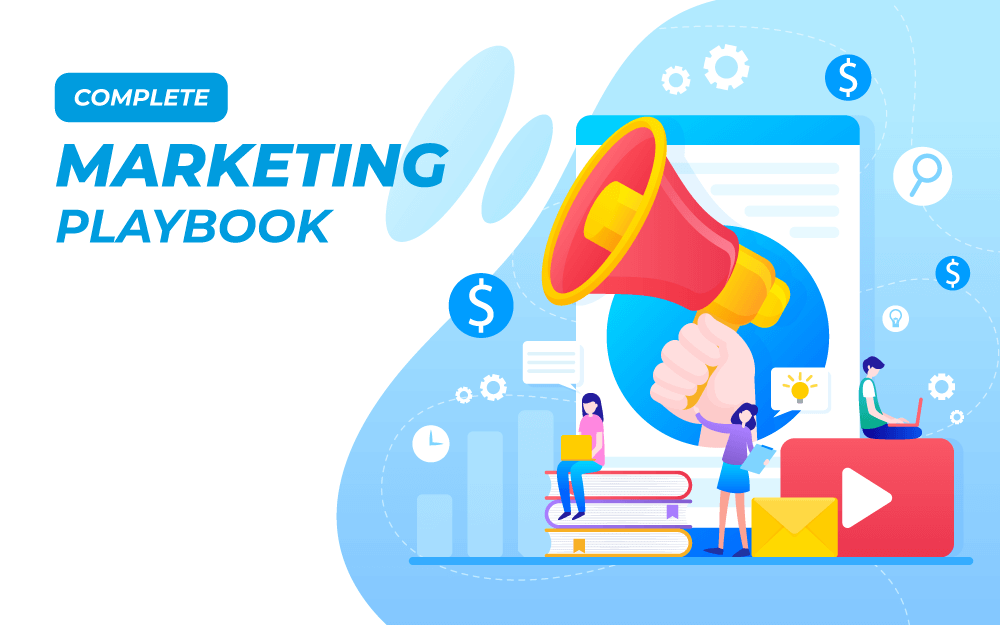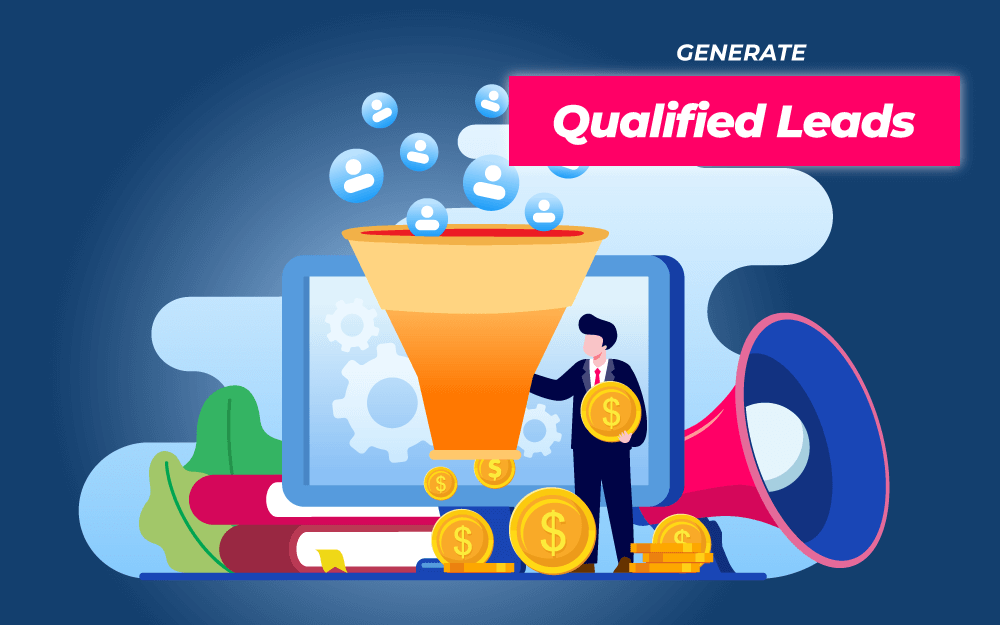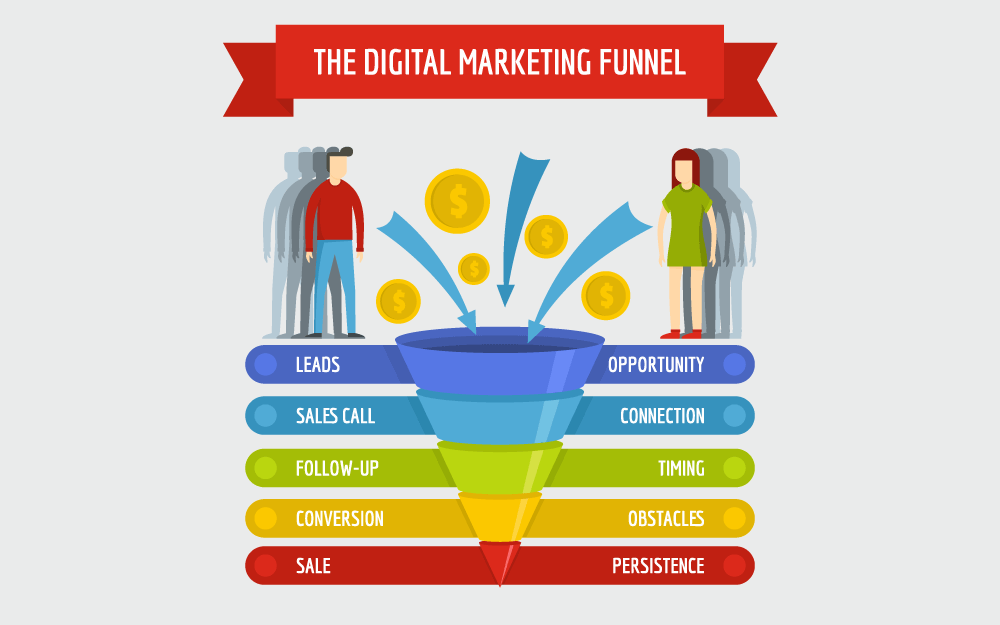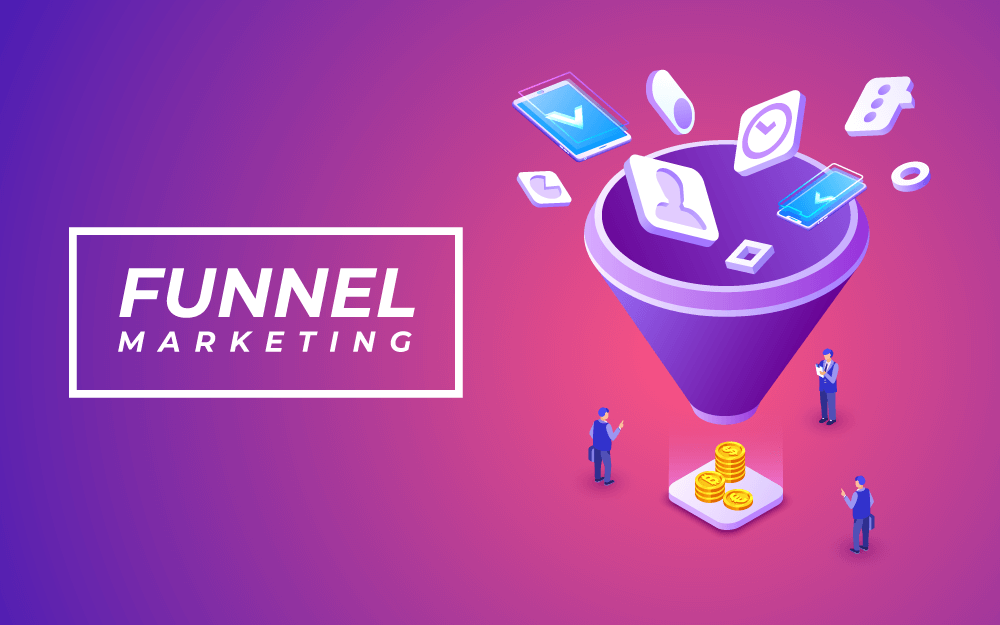
It’s Not Easy!
We work with many startups, entrepreneurs and small business owners who come into the Ideal Sales Leads Master Affiliate Program. We hear it again and again: the product is great, but how do I tell the world and uncover the leads to gain appointment settings? I’ve tried to do “digital”, ie. doing some search on Google, publishing some content on LinkedIn, maybe even tried a few ads but it “doesn’t really work”…. In other words, they don’t get the results they were expecting (hoping for?!) and are not sure what to do next… Frustration sets in.
Some quit, thinking “there’s no real demand”, most want to get help but don’t know how or get scared having to invest advertising money convinced the product should sell itself through word of mouth and a simple call, email or personal visit…!
Well, big news: it’s a crowded world out there, and your message is likely to get drowned in a sea of noise if you don’t take the steps to differentiate.
The content of this article is originally published on An intro to B2B digital marketing for startups and SMBs by Max Bonpain.
But there is hope!
Digital Marketing works! It’s just harder than it looks, especially for B2B 😉
This short article aims to give you, the entrepreneurs and small business owners, a view of what you might be doing wrong and how to get it right.
We’ll take you on a step by step approach to improve the digital marketing component of your lead generation sales process.
1 — Clarity of Objective
Most businesses try and manage short term (lead generation) and long term (brand awareness) objectives at the same time, from the start.
But building brand awareness is hard and expensive, and won’t pay back (you need brand preference to get chosen, not just awareness) and usually our sponsors take care of brand imaging: Instead, focus your budget on lead generation in the short term and try and build your brand as a collateral. By this, we mean as an added benefit of your lead generation activity, eg: Speaking at a trade conference or conducting a webinar or creating a short video will build your brand as well as generate leads.
As a rule of thumb, you should be spending 90% of your marketing budget on lead generation in the first few years, gradually reducing to 40% (over 3–5 years) as your business generates more cash and you can afford spending more.
=>Be single minded: the objective is lead generation (which our sponsors will appreciate!)
The tactical activities bring in the cash to fund the strategic ones.
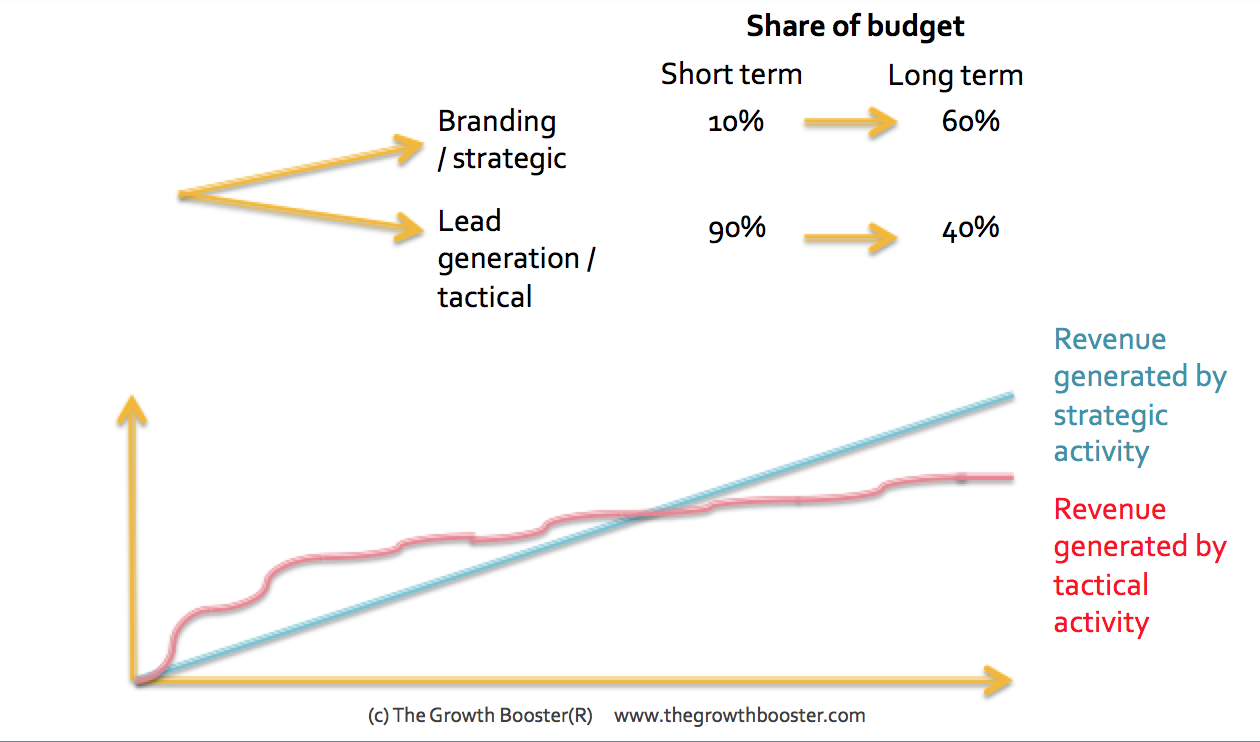
2 — Digital Strategy
Now you need to think about which digital assets and channels are most appropriate for your business and which role they should play in your lead generation: is your website the hub where you want to drive people for a demo? Are you building a database? Do you want them to download an app instead?
This is the overall process from lead generation, remarketing, nurture, etc.
Think about how people are searching, comparing and buying your product.
A B2B example:

3 — Understanding the purchasing decision journey
Your objective is to accompany your prospects along their decision journey by mapping your content and website to meet the demands of all stages and stakeholders:
-How do they decide?
-What are their triggers and barriers to purchase?
-Who do they listen to?
-Where do they find information?
-What are their decision criteria?
You want to create a matrix for the key stakeholders and the key stages in the decision process: a CFO might need a business case with an ROI, whilst a CTO might need to understand technical implementation and make sure it’s easy to integrate.
4 — The journey translates into a “sales funnel” or “pipeline”

*Your target is the universe of potential customers you want to reach, for instance all coffee shop owners in NSW or telco providers in Europe or all B2B in a particular zipcode…
*The MQLs (marketing qualified leads) are the people who give you their detail in response to your activity (or sometimes proactively!). You need to “qualify” them to understand who to prioritise: are they the right type of leads (right role in the right company or industry), and where are they in their decision process (just browsing or ready to buy)? (See next step below for more detail)
-If they are the right type but not ready to buy, you want to include them in a nurturing CRM program, likely to be through eDM for cost reason — in other words, keep them interested so when they’re ready to buy they think of you first!
-If they are advanced in their decision-making process, they are handed over to sales and become SQLs (sales qualified leads) to do any technical test and draft the commercial terms and conditions: the relationship needs to be much more personal. From there, a number of opportunities will be generated, and you’ll manage to close a few deals!
*It is important to capture, measure and monitor the interactions with your leads as they are good indicators of any move in the process. The ambition is to convert more and speed up the whole sales cycle. You can use our proprietary sales management software and even link to other commercially available CRM softwares — they are a few free ones. They include Zoho, Hubspot, Pipedrive or (if you’re bigger) Salesforce.
5 — Qualifying marketing leads
Qualifying marketing leads helps sales focus on the most promising ones and save time:
If you have done your targeting properly in your campaigns, you should only get the “right” type of leads. If you don’t, you need to update your criteria (and make sure they have been agreed between sales and marketing first!)
The tricky part is to understand where the leads are in the decision cycle: you know that by making sure your content is clearly addressing a single stage of the process, and that you have different pages and have tags / anchors / pixels on your website indicating what content they’re looking at:
- is it some high-level thought leadership? They are likely to be early in the process…
- Are they using your ROI calculator or checking FAQs? They are worth a phone call!
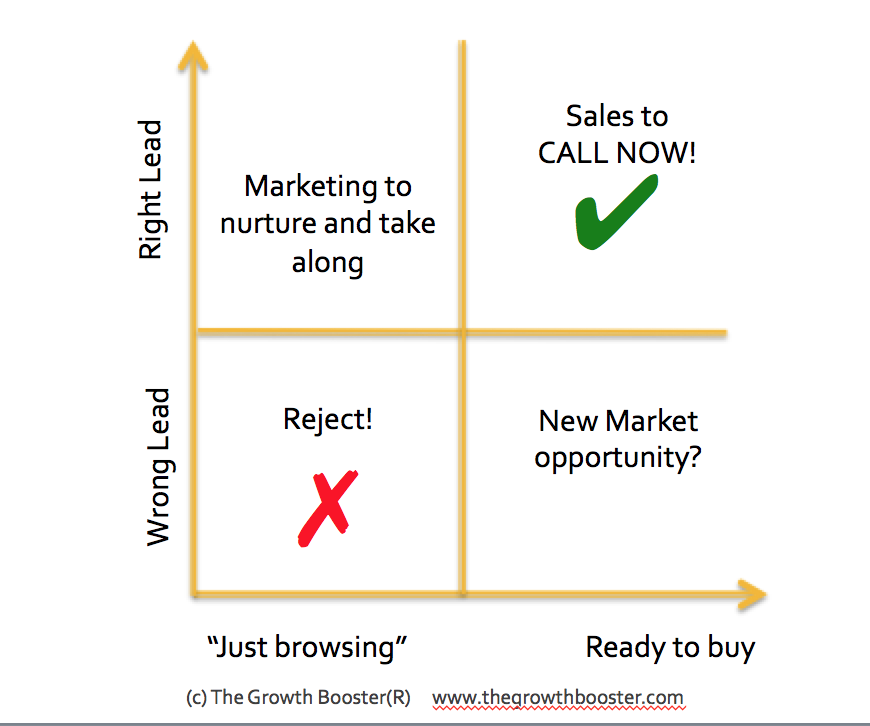
Tips for your Website:
-Make sure you are easy to reach and capture leads contact details in your database
-Your web content should cater for all stages of the decision journey but be clearly defined
6 — Nurturing
Our recommended nurturing program (ie. keeping leads warm until they’re ready to set an appointment!) encourages taking your leads along the decision journey: if there are 4 steps in the leads research and decision process and it takes 1 months on average to conversion, you might want a “4 weekly emails and 1 call” nurturing process, with content adapted to each stage and each target market.
Done well, nurturing helps you convert more and speeds up the whole cycle… and it’s cheaper (free if you use eDMs) than lead generation! We recommend utilizing our Ideal Sales Lead 5 touch point system. Email, Telephone Call, Personal Visit, Follow up Email and then Telephone call.
You can complement eDMs with ads, hospitality and other activities, but make sure you capture them in your CRM so you can analyse the efficiency of each activity (eg, did the business lunch generate new leads?)
7 — Your Content Matrix and Calendar
By now, you should have a clear view of who you want to reach and where/how they are looking for information: LinkedIn, Google, your website, specialized magazine, trade conferences, all of the above?
Building on the “who” and the “where”, you need to add the “what”, ie the content: it can be anything from a video to a blog, to a social post, to a paid ad….
It is usually best to “repurpose and republish” your content: if you have an article, why not make a video out of it… if you have a long-form (eg thought leadership) paper, why not cut it into several short form (eg articles) papers…
Remember to cover all stages and all stakeholders with your content, which might just mean rewriting with a different angle for the CFO than you did for the CTO… Ultimately you want to reach the decision maker, however….. Don’t forget journalists, influencers, investors, suppliers and all other stakeholders, even if for a later stage!
Keep in mind your objective for each piece of content: you can use a white paper to generate leads (by asking for details to download) or simply create awareness (by distributing freely)
Your content matrix
Your content matrix helps you list all the content you need to generate, and what form it should take. From there, you can create a content calendar with the key milestones for each piece of content.
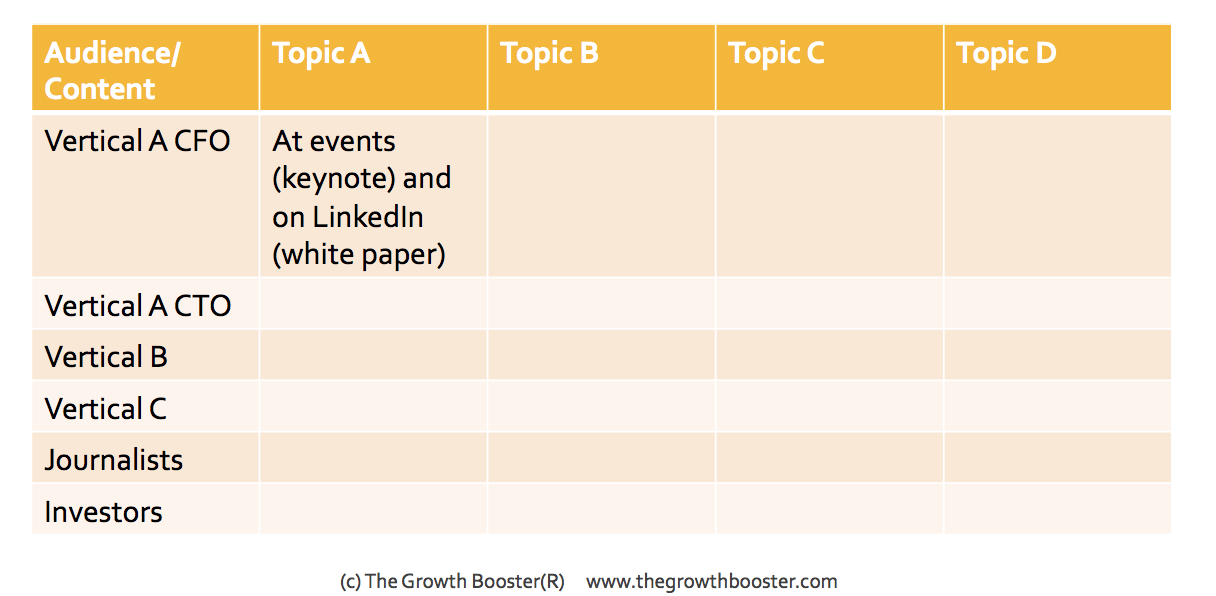
8 — Measure, measure, measure
You’ll need to set up a scorecard for your key activities, tracking the main KPIs versus previous month and a benchmark (eg your last 3m average) to see whether you are improving or not.
Remember, absolute numbers are useful (how many visitors on my website) but conversion rates and costs are better as they give you an indication of how to improve.
The score-card will help you allocate your budget and improve your ROI. It will also give you arguments for your investors to show you can generate new business.
Include offline activities if relevant (eg amount paid for speaking / exhibiting at a conference and number of leads generated), to have a full view and compare all touch points.
Example of KPIs in scorecard

9 — It doesn’t work? Yet…!
If you’re just starting out, put small budgets to test and learn and build a benchmark.
If you’re not getting the results you’re hoping for, consider whether you have:
-The right message / offer: is your content attractive (is it being opened and read?!)
-The right people: are your targeting criteria too broad?
-The right place (channel and context): should you be on LinkedIn rather than Facebook?
-The right time: are you reaching your audience at the right stage of their decision journey
-The right price: is your budget well allocated and your bids competitive enough?
10 — Money, money, money!
For “new starters”, the big question (and related anxiety) is about budget: how much can I afford and how much should I invest?
Well, as long as you get a return on your spend, you should invest!
The good news is you can start with low budgets: blogs, SEO, LinkedIn invites are free and you can do low budget advertising tests to build your funnel and understand conversion rates and cost per leads.
Even though attribution models have shown that reaching target audiences through different channels delivers an incremental conversion rate overall, there is a minimum threshold of spend for efficiency, so my advice is to test a couple of things but then invest in the single most effective channel. You can add new channels once you hit diminishing returns.
Importantly, use your digital channels to amplify any offline activity: advertise that conference you’re going to speak at, make sure you put the leads you get there in your CRM system, and nurture them as appropriate.
Want to know more or get some help? Reach out!
Harold@IdealSalesLead.com or 318-349-4998
